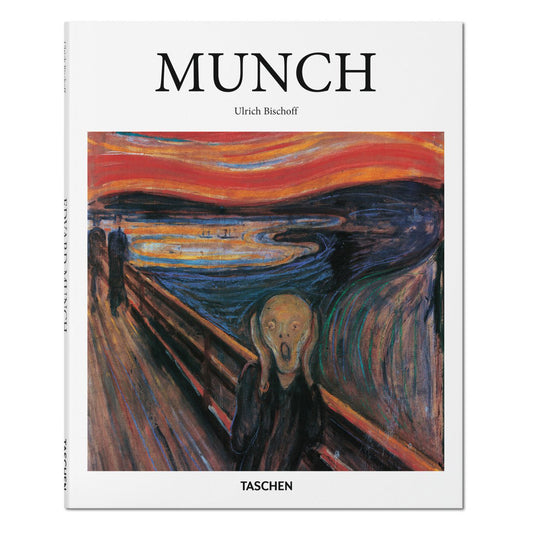Edvard Munch „Der Schrei“ gestanzte Notizkarte
Edvard Munch „Der Schrei“ gestanzte Notizkarte
The Unemployed Philosopher's Guild
Nicht vorrätig
Verfügbarkeit für Abholungen konnte nicht geladen werden
- Inklusive Umschlag und Aufkleberbogen
Product Details
Product Details
- Product type: Leere Notizkarte
- Shipping Dimensions: 8.75 × 4.0 (22.2 × 10.2 cm)
- Shipping Weight: 0.13 lb (2.0 oz; 57 g)
- SKU: SKU: SKU010002636
- UPC: 814229003304
Share



Über den Künstler
Edvard Munch
Edvard Munch (1863–1944) was born in Løten, Norway, and studied design and art in Oslo. In May of 1885 he traveled to Paris on a scholarship, and after the deaths of his sister and father the following year, he began to spend most of his time in France. His painting first achieved fame with an 1892 exhibition in Berlin, which also led directly to his influence upon the German Expressionists. Despite struggles with alcohol and mental health, Munch lived to the age of 80.
Mehr Edvard Munch
-
Lenticular Postcard: Munch (The Scream)
Normaler Preis £2.47 GBPNormaler PreisStückpreis / pro -
Emaille-Magnet: Munchs Der Schrei
Normaler Preis £9.07 GBPNormaler PreisStückpreis / pro -
Haftnotizen „Der Schrei“ von Edvard Munch
Normaler Preis £7.55 GBPNormaler PreisStückpreis / pro -
Lenticular Postcard: Munch (The Scream)
Normaler Preis £2.47 GBPNormaler PreisStückpreis / pro -
Art Button: Botticellis „Geburt der Venus“
Normaler Preis £3.03 GBPNormaler PreisStückpreis / pro -
Art Button: Munchs „Der Schrei“
Normaler Preis £1.52 GBPNormaler PreisStückpreis / pro -
Hokusais Die große Welle vor Kanagawa Pix Brix Set
Normaler Preis £68.27 GBPNormaler PreisStückpreis / pro -
Edvard Munch: Liebe und Angst
Normaler Preis £37.90 GBPNormaler PreisStückpreis / pro -
Munch und Expressionismus
Normaler Preis £45.52 GBPNormaler PreisStückpreis / pro

Über das Brand
The Unemployed Philosopher's Guild
The origins of the Unemployed Philosophers Guild are shrouded in mystery. Some accounts trace the Guild's birth to Athens in the latter half of the 4th century BCE. Allegedly, several lesser philosophers grew weary of the endless Socratic dialogue endemic in their trade and turned to crafting household implements and playthings. (Hence the assertions that Socrates quaffed his hemlock poison from a Guild-designed chalice, though vigorous debate surrounds the question of whether it was a "disappearing" chalice.)
Others argue that the UPG dates from the High Middle Ages, when the Philosophers Guild entered the world of commerce by selling bawdy pamphlets to pilgrims facing long lines for the restroom. Business boomed until 1211 when Pope Innocent III condemned the publications. Not surprisingly, this led to increased sales, even as half our membership was burned at the stake.
More recently, revisionist historians have pinpointed the birth of the Guild to the time it was still cool to live in New York City's Lower East Side. Two brothers turned their inner creativity and love of paying rent towards fulfilling the people's needs for finger puppets, warm slippers, coffee cups, and cracking up at stuff.
Most of the proceeds go to unemployed philosophers (and their associates). A portion also goes to some groups working on profound causes.
-
Museum Store Association Member
The Museum Store Association supports the cultural non-profit retail industry and the people who work in it.
-
Supports Non-profit Organizations
A portion of proceeds is donated to non-profit organizations. See description for details.
-
Designed in USA
Designed in the USA, with global manufacturing or assembly.
Mehr von The Unemployed Philosopher's Guild
-
Bob Ross magnetische Fingerpuppe
Normaler Preis £6.79 GBPNormaler PreisStückpreis / pro -
Frida Kahlo Magnetische Fingerpuppe
Normaler Preis £6.79 GBPNormaler PreisStückpreis / pro -
Pokal für moderne Kunst
Normaler Preis £15.14 GBPNormaler PreisStückpreis / pro -
Frida Dreams Tasse
Normaler Preis £15.14 GBPNormaler PreisStückpreis / pro -
Magnetische Fingerpuppe Diego Rivera
Normaler Preis £6.79 GBPNormaler PreisStückpreis / pro -
James Baldwin „Kleiner Denker“ Plüschpuppe
Normaler Preis £18.21 GBPNormaler PreisStückpreis / pro -
Rembrandt - Gestanzte Notizkarte mit Aufklebern
Normaler Preis £3.00 GBPNormaler PreisStückpreis / pro -
Claude Monet Magnetische Fingerpuppe
Normaler Preis £6.79 GBPNormaler PreisStückpreis / pro -
James Baldwin Magnetische Fingerpuppe
Normaler Preis £6.79 GBPNormaler PreisStückpreis / pro -
Vincent van Gogh magnetische Fingerpuppe
Normaler Preis £6.79 GBPNormaler PreisStückpreis / pro






















